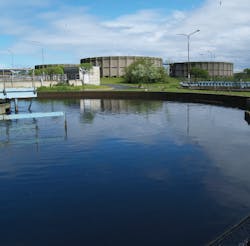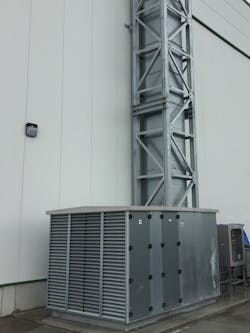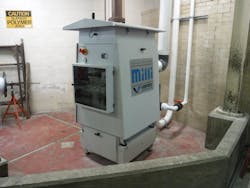Odor control is often a necessary reality for wastewater utilities. Either to abide by local regulations or to maintain good community standing, utilities can find themselves working to mitigate odorous compounds in their collection systems, treatment facilities and solids handling facilities.
There are no federal regulations for odor control at wastewater treatment plants. However, left unhandled, odor can cause significant strain with nearby communities. States and communities have many unique regulations and requirements. Nationwide, though, the approaches to odor control use the same technologies.
Two Odor Control Approaches
To effectively control odors, wastewater utilities should first identify the cause of the nuisance odor and then identify the most effective technology to resolve it.
The most prominent compound responsible for odor is hydrogen sulfide. Other prominent compounds include methanethiol, ammonia, and volatile fatty acids. Many of these compounds are the byproducts of microbial activity, often under anaerobic conditions.
Odor control for wastewater collection and treatment includes two main approaches: vapor-phase technologies and liquid-phase technologies. Vapor-phase technologies control the odorous compounds in gasses and the air, while liquid-phase technologies control the compounds and microbial activity in the wastewater itself.
These two approaches each have their own host of unique solutions, as touched on below.
Vapor-phase Technologies
Vapor-phase technologies draw in and treat air from the sources of odorous compounds. These technologies are directly involved with ventilation to ensure that air is only discharged after treatment, often solubilizing the compounds.
Some prominent vapor-phase technologies to deal with wastewater odor control are as follows:
Wet air scrubbing is a vapor-phase odor control approach where the system adds the targeted compounds to a chemical solution. For example, sodium hydroxide or sodium hypochlorite can be used to solubilize hydrogen sulfide. A single-stage system can use a single solution to solubilize targeted compounds, whereas a multi-stage scrubber can treat the air through a series of treatments. The approach can treat for most prevalent odorous compounds.
Liquid redox uses an aqueous solution of chelated metal to remove hydrogen sulfide from a gas and convert it into solid, elemental sulfur. Compared to wet air scrubbing, liquid redox processes have higher capital costs but lower operating chemical costs.
Biofiltration uses microbes to solubilize multiple odorous compounds. They are effective at removing sulfur-based compounds, but not as effective at removing nitrogen-based compounds.
Solid scavengers convert sulfur compounds into more stable compounds through reactions that consume the medium itself. They are ideal for treating biogas with low to moderate levels of hydrogen sulfide.
Carbon adsorption systems attract multiple odorous compounds from the air, adhering them to its surface. It can remove hydrogen sulfide and other sulfur-based compounds well, but these systems are less effective at treating nitrogen-based compounds.
Liquid-phase Technologies
Liquid-phase technologies treat the wastewater stream itself to minimize the release of odorous compounds from the stream, often by adding chemicals to the wastewater.
Liquid-phase technologies are more often used in wastewater collection systems, rather than wastewater treatment plants. This treatment prevents hydrogen sulfide from escaping into the air, which also prevents corrosion. A single application point of liquid-phase technology can provide odor control for multiple odor release points, such as utility maintenance holes and re-pump stations.
Some prominent liquid phase technologies are:
Iron salts can oxidize or precipitate dissolved sulfide, turning it into ferrous sulfide and ferrous iron. At the treatment plant, aeration can then turn these compounds into sulfate and ferric iron. Iron salt solutions are classified as hazardous compounds and require appropriate handling.
Oxidation for odor control involves a strong chemical oxidizing agent, which chemically reacts with dissolved sulfide to convert it to sulfate or sulfur. The hazardous agent can also treat many other odorous and non-odorous compounds. One of the most commonly used oxidizers is hydrogen peroxide.
Lastly, the application of the chemical compound anthraquinone can also interrupt the processes of sulfate-reducing bacteria, controlling the presence of odor-causing sulfide.
Today’s Solutions
The market for wastewater odor control provides a number solutions for utilities to choose from, each providing a unique approach to specific odor control technologies. Some of today’s odor control solutions providers include:
SciCorp
www.scicorp.net
Kusters Water
www.kusterswater.com
Vapex Environmental
www.vapex.com
Veolia Water Technologies
The first step is a “reduction” step where a reagent is added and removes electrons from the sulfide molecule, converting the sulfide into inert and safe elemental sulfur that cannot reform into sulfide. The second step is a regenerative oxidation process, where the reagent reacts with an oxidant converting it back to its original form, ready to attack and reduce another sulfide molecule. This process continually works to enable the rapid and efficient destruction of sulfide until H2S levels have been reduced to an acceptable level.
www.watertechnologies.com
Read more content online
Looking for more odor control information, products and solutions? Visit www.wwdmag.com/33007964 for an introductory article and check the related content for even more.
About the Author

Jeremy Wolfe
Jeremy Wolfe is a former Editor for Wastewater Digest.




